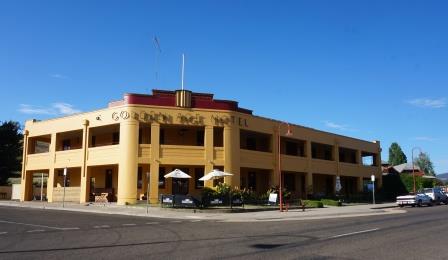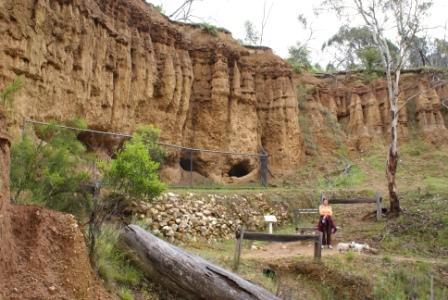OMEO (includes Oriental Claims Historic Area, Justice Precinct and Cassilis)
(www.northeastvictoria.online)

The friendly town of Omeo (population 300) has a wide range of accommodation in and around the town, including motels, two art-deco hotels, apartments, and a nice caravan park alongside Livingstone Creek.
Dining options include the hotels (The Golden Age, and the Hilltop) as well as the bakery, and two coffee shops.
The Omeo area was first documented by Europeans in the 1830s with the arrival of Polish explorer Johan Lhotsky in 1832 (his birthplace is now in the Ukraine). Following on from Lhotsky’s good reports, the ’overlanders’ arrived from New South Wales - amongst them many names still revered in the district - Livingstone, McFarlane, McMillan and Pendergast.
Pastoral property Omeo A was first taken up by John Pendergast who came from the Monaro District in 1836; Omeo B was subsequently taken up by James McFarlane, and another early settler, John Hyland, settled west of Morass Creek, where his property was named Hinnomunjie Station.
Noted explorer, Angus McMillan, passed through the area in 1840 and on his final expedition he established a north-south route from Omeo through to Bass Strait. This is basically the same route followed today by the Great Alpine Road through the Tambo Valley to Bruthen, and then Bairnsdale, a route that had been used for many thousands of years by local aboriginal people.
Gold was discovered on Livingstone Creek (which runs through the centre of Omeo) in 1852, but because of their comparative isolation the Omeo goldfields were developed slowly. The era of gold mining peaked in the 1860s, and by the turn of the century there were only a few minor claims still being worked.
The isolation of Omeo gave the mining town a notoriety (probably well deserved) of being a lawless community. The first magistrate in town was a James Brown, better known by his nom-de-plume, Rolfe Boldrewood, author of that Australian classic ’Robbery under Arms’. Brown considered the Omeo goldfields to be the roughest and toughest in Australia, and wrote about those interesting times and places in his novel ’Nevermore’.
Evidence of Omeo’s gold mining history can be seen at many points around the township, oriental tombstones, sluice channels, and the occasional grain of gold picked up from Livingstone Creek.
Omeo’s era of post-gold mining prosperity came to a temporary end in 1939 when devastating bush fires destroyed many of the town’s buildings (the fires of 2003 came perilously close to doing the same thing!).
However, gold is back in favour and the town has an atmosphere of prosperity, with many imposing buildings in its main street. It makes a great base camp from which to explore the area.
Click here for the Omeo Caravan Park website.
Justice Precinct
Omeo has an neat collection of buildings within its Justice Precinct, a mix of structures that were all part of the great anglo-saxon tradition of a fair and open justice system.
The buildings in the Precinct (the A M Pearson Historic Park) range from formally designed buildings (such as the Court House) to a traditional Log Gaol (last used in 1981). Other structures in the Precinct have been erected here as a memento of life in a bygone era.
The Precinct is on the corner of Short Street and Day Avenue (the Great Alpine Road) and will take about an hour to explore, given that the main buildings are open. The grounds of the Precinct are always open, but you need to contact the Visitor Information Centre for opening times of the main buildings.
As well as the description given here, the VIC has a brochure on the Precinct, as does the Omeo Historical Society website (see below).
Occupying the most prominent part of the Precinct, the Omeo Courthouse was built in 1893, and is a mix of an ornate and federation style, having been designed by A J MacDonald, Walter Burley Griffin’s assistant during his work on Canberra. The original courthouse (now a museum) is to the rear of the 1893 building, having been erected in 1861.
Up the hill, and off to the right from the Courthouse, the Log Gaol was built in 1858, and was last used in 1981. The exercise yards were removed during the late 1930s, and the attached cook house became an office for police officers based in Omeo.
Only when the Victorian Police Association threatened a black-ban on working at Omeo, did the entire structure fall into disuse - but fortunately preserved by the Historical Society. The new Police Station is clearly visible, just over the fence from the Gaol.
Opposite the Gaol, and on the same level, the stables were built in 1893, and were used by mounted police and their four legged mates for about 50 years.
At the front of the building, there is a horse watering trough, one of many hundreds manufactured in Australia by wire maker, cum-manufacturer, William Bills during the mid-late 1800s.
Upslope from the Gaol, the former Police Residence dates from the late 1800s, and is currently used by the Historical Society as an office and archive facility.
Back down the slope (towards the Courthouse), the small building here was the stables for the magistrate’s horses, and was in use for about 50 years, until reliable motor transport, and reasonable roads put many horses out of a job.
To the rear of the Courthouse, the blacksmiths shed provides an insight into what the phrases ’goods and services’ and ’hardware’ meant in the 19th Century. The structure seen here is not the original, but it’s certainly authentic, inside and out.
Upslope from the blacksmiths, the machinery shed is home to a variety of relics from the early age of machinery, and transportation. The first car was driven into the Omeo district in 1908, followed by the first trucks about 15 years later.
Just downhill from the blacksmiths, the waterwheel displayed here is from the Zulu Creek gold fields (north-east of Omeo, just off the Corryong Road); it was used to power a gold crushing stamper.
Livingstone Park

Livingstone Creek circles around the township of Omeo before passing to the north of the urban area, on its way to join the Mitta Mitta River as part of the vast Murray-Darling Basin.
The parklands described here are easily accessible from the centre of town, and provide an interesting network of walking tracks, as well as many opportunities for picnics and barbeques.
Heading down towards the Park from Day Avenue, the walking track to the caravan park veers off to the right, with this mostly creekside walk taking about 20 minutes to complete. If you are staying at the caravan park, this makes a nice way to collect the morning’s newspapers.
Keeping straight-ahead where the caravan park tracks goes off to the right leads over a small bridge into a fairly formal area, with several picnic amenities to hand. This also leads to the Omeo swimming pool (formed by damming Livingstone Creek) and some more walking tracks.
Crossing over the creek inlet to the swimming pool, you can head off to the left so as to get to the Oriental Claims Historic Area (about 1800m away - one hour return, see below) or head upslope to a local lookout.
Oriental Claims Historic Area
The Oriental Claims Historic Area encompasses a bizarre landscape of eroded cliffs, some more than 60 metres high. For more than 50 years prospectors worked the Livingstone Creek area in search of gold, and much evidence of this is still visible.
Using an ingenious system of water races, and high pressure hoses, the mineral bearing soil was gouged out from the surrounding cliffs. It was one of the few profitable goldfields of the day, especially for alluvial miners who took an estimated 58 000 ounces of the precious metal.

The Claims Area has some good walks (AWTGS-3) around the old gold mining areas, and these provide plenty of interest, although not really suitable for young children as there are several mine pits still open in the area.
See Staying Safe in the Australian Bush : A Travellers Guide (published by Rosella Publications; author Andrew Monroe) for some relevant safety information regarding old mine sites.
The Ah Fong Loop provides about 45 minutes of well graded walking (the majority of the ’ups’ and ’downs’ occur at constructed steps). Access is via a small bridge over a creek, and at the finish of the track there are picnic/barbeque facilities, a delightful area in summertime.
The Pioneer Claim Loop also takes about 45 minutes, with the major feature of this walk being the stark cliff faces that are a legacy of the sluicing operations that took place in the search for alluvial gold.
The Parks Victoria website (see below) has a handy PDF file, with maps and further information on the Historic Area; printed copies of the same PDF are available from the Visitor Information Centre in Omeo.
It is also feasible to walk from the township to the Claims area, with access being via Livingstone Park, just off the town centre (Creek Street). From the swimiming pool area, either take the roadway heading off upstream (that is, following Livingstone Creek upstream) or cross over the spillway of the swimming pool, and turn left at the top of the small ridge (the right turn at this point leads to Bakers Island, an ’island‘ in the midst of the Creek drainage system).
The former access route needs to be followed to the end of the roadway, and at this point you need to ford the Creek, and pick up the walking track heading off to the left (only do this in low water conditions).
The latter access follows a ridge system (part of the swing terraces of the Creek) before dropping down to the Creek side to meet the other access route.
In either case, do not attempt this walk on a warm summer’s day without gaiters, as there usually snakes down by the Creek.
After the walk, you might like to cool off in the swimming pool, a still water section created by a small weir on the Creek, but do not swim anywhere near the spillway system.
Details of these walks are also available in the excellent brochure Omeo Region Walking Tracks and Trails available from Visitor Information Centres at Bright, Omeo and Bairnsdale.
Cassilis Historic Area
The Cassilis Historic Area can be found to the east of Omeo, and is accessible via a signposted turn-off on the Great Alpine Road (on the Mount Hotham side of town), and from the Cassilis Road at Swifts Creek (turn west at the supermarket).
Gold was first discovered in the area in about 1885, and at the peak of mining operations it had a population of more than 500; today it is just a ghost town, with several interesting relics from the boom times.
The Reserve extends for about eight kilometres along the Cassilis Road from Tongio West, to the top of Cassilis Gap (the Mount Delusion Road), and includes the former mining operations of the Cassilis Gold Mining Company, as well as the King Cassilis Company. The main area of interest is the collection of relics referred to above. These can be accessed by taking the signposted turn-off to the south at Tongio West, about 10km east of Swifts Creek, 20km from Omeo.
The access track here curves around the back of a farming property, before crossing over a small creek (impassable after heavy local rain); this then leads to a small car parking area, with many of the said relics being in full view.
Amongst the items of interest are the stone cycanide vats (cyanide was used in processing the gold ore), as well as the Jirnkee Water Race. This was the longest water race in the southern hemisphere, being about 76km long, and was used to gather water from local catchments to keep up with the gold mines’ insatiable appetite for water.
A brochure on the area is available from the Visitor Information Centre in Omeo, as well as several retail outlets in Swifts Creek, and it is worthwhile grabbing a copy before tackling this detour.
Cassilis was named after a small township in Scotland, and its goldfields were largely powered by Victoria’s first Hydro Electric power station (on the Victoria River) which first generated power in 1908 - see the Great Alpine Road description for more details.
The Cassilis mines closed down in the early 1900s, and the town soon declined in importance, along with its neighbours such as Brookville. The 1939 bushfires destroyed much of the town.
Also in the Cassilis Valley, Mount Markey Winery and micro-brewery is a farm gate producer of Wine, Beer, Cider and Mead; see the Omeo VIC website for more details.
If you have the time, there are two interesting walks in this area, the Jirnkee Water Race and the King Cassilis Mine (both AWTGS-3).
The first of these is a two kilometre loop, with some steep sections, and starts a few hundred metres past the Haylock Track intersection.
There is a large tree stump alongside a small car parking area (easy to miss) and from here, take the walking track off to the right. This leads to some interesting sections of the former Water Race, and then a steep descent back to the roadway.
Allow about two hours for this walk, and take walking poles for the steep descent.
The second walk leads to the former mining site known as King Cassilis Mine (also known as the Mount Hepburn Mine).
This two kilometre walks leads uphill to the workings of the mine site, with many relics of those boisterous days all around.
Access is by taking the Charlotte Spur Track (unsealed, off to the right), and then a signposted turn to the left. This leads to a small car parking area, and the start of this interesting loop walk.
Take care on the steep sections, and enjoy the views as well as the old machinery.
Details of these two walks can also be found in the previously mentioned brochure Omeo Region Walking Tracks and Trails available from Visitor Information Centres at Bright, Omeo and Bairnsdale.
GREAT ALPINE ROAD (Wangaratta, Bright, Mount Hotham, Omeo, Bairnsdale)
MOUNT BEAUTY to OMEO (via Bogong Village, Falls Creek and Bogong High Plains)
WODONGA to OMEO (via Mitta Mitta township, Mount Wills, Glen Valley and the Blue Duck)
CORRYONG to OMEO (via Sassafras Gap and Benambra)
Intro Screen on a fresh browser page
Omeo Visitor Information Centre
COPYRIGHT © 1995-2020, Chris McLaughlin.